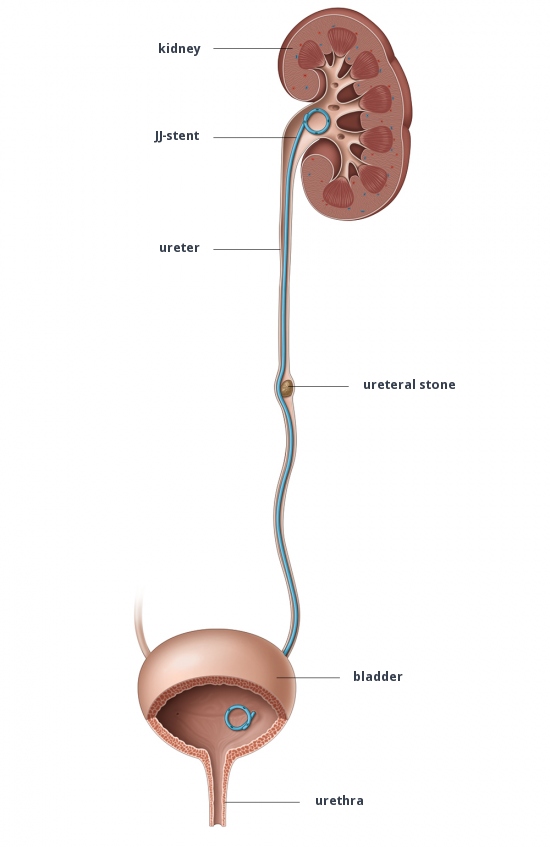 JJ Stent
JJ Stent
This means inserting a fine tube into the ureter (tube from kidney to bladder) to bypass a blockage and enable the kidney to drain satisfactorily. The shape of the tube helps the stent remaining place until it is removed in a second procedure.The stent may be put in place during an open operation (eg during surgery on the ureter), from above through the skin over the kidney, or from below via the bladder using an operating telescope (eg after endoscopic removal of a stone from the ureter).In principle, a guide wire is passed into the correct position and checked with X-rays. The stent is then threaded over the guide wire. When the wire is withdrawn, the stent resumes its naturally curled shape at either end.
RISKS
These are the commoner risks. There may be other unusual risks that have not been listed here. Please ask you surgeon if you have any general or specific concerns.There are risks associated with any anaesthetic.You may have side effects from any drugs used. The commonerside effects include light-headedness, nausea, skin rash and constipation.
The insertion of double JJ-stent has the following specific risks and
limitations:
- If the stent is being used to relieve a blockage, the urine may already be infected. Despite antibiotics, you may develop a fever and chills from infection and require further antibiotic treatment.
- The stent cannot be left in place indefinitely and must be removed when no longer needed, or changed three-monthly.
- There may be some trauma to my ureter during its positioning. Rarely, the guide wire may perforate your ureter or kidney.
- There may be some bleeding from my kidney or ureter, which rarely may be severe, requiring treatment.
- The stent may move from its intended position, reducing its efficiency and requiring repositioning or replacement.
- You may have some bladder and / or kidney discomfort associated with the stent, but symptoms can be treated.
- Your stent may block, requiring it to be removed or possible replaced.
- You may develop an infection in the bladder or the kidney. This may require antibiotics, or occasionally removal of the stent.
Some of the above risks are more likely if you smoke, are overweight, diabetic, have high blood pressure or have had previous heart disease.
When you are discharged, take care of the following:
- You can continue with your normal daily activities (eg. Driving, sexual activities, walking, exercise & travel)
- Drink enough fluids (1-2 litres per day)
- Take your medicine as prescribed
- You can relax in a hot bath or shower if you experience discomfort
- Rest when you can
- If urine becomes blood stained, increase your fluid intake
- Make sure you attend to your follow-up appointment to remove the JJ-stent: usually within 2 weeks of stent placement if removed in theatre and +/- 2 day’s if to be removed in the rooms (your doctor will confirm whether it will be taken out in theatre or in the rooms)
Contact your doctor if you experience any of the following:
- constant, unbearable, persistent pain;
- fever-like symptoms;
- nausea or vomiting;
- difficulty in passing urine;
- if your stent falls out;
- if you notice a significant increase of blood in the urine
